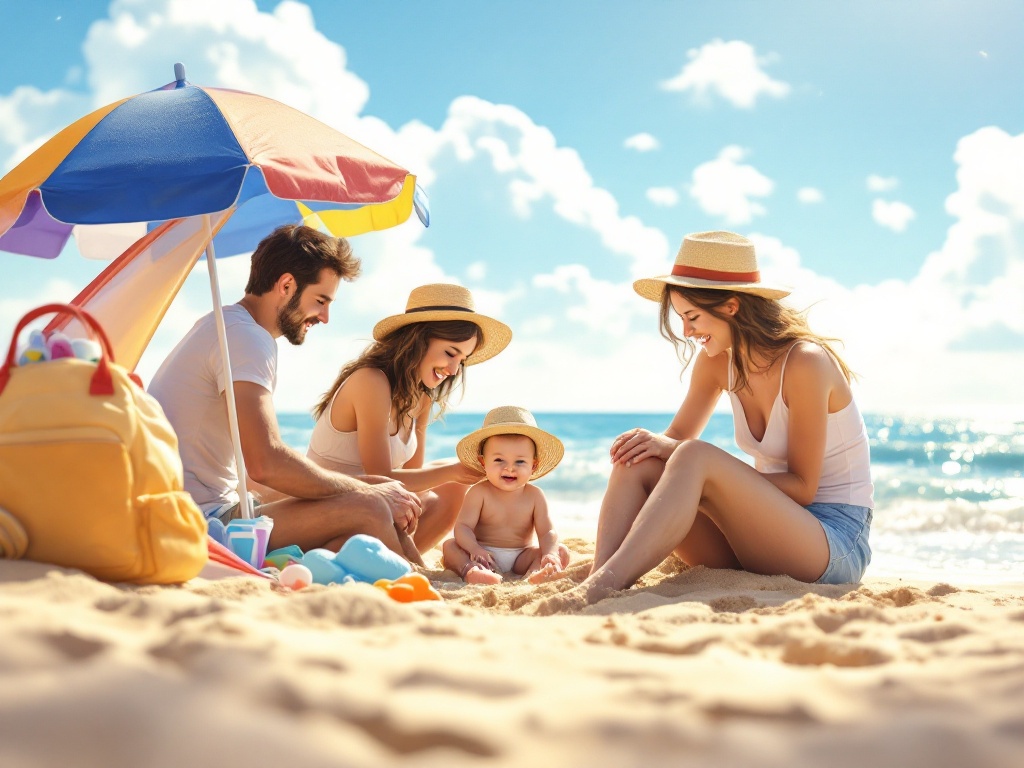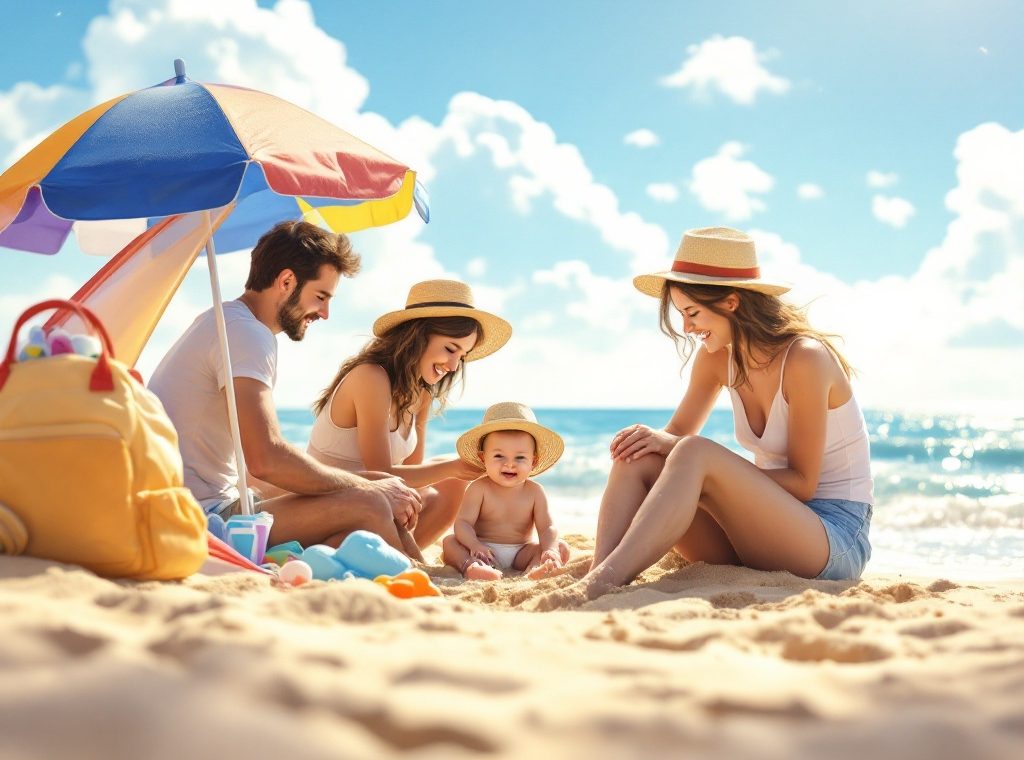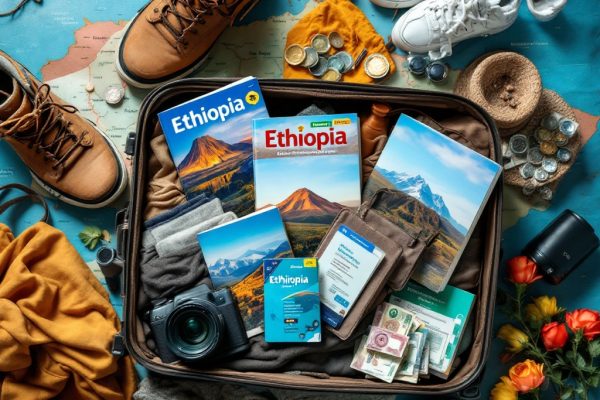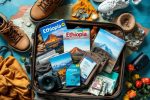Tips for Taking a Baby to a Beach: Safe Visit to the Sunny Bays
Planning a beach trip with your baby? Discover essential tips for a safe and fun experience! Learn how to protect your baby’s delicate skin from the sun with proper sunscreen application and shade. Explore key items for your packing checklist, from a well-stocked diaper bag to a UV-protective beach tent. Ensure a comfortable and healthy outing by mastering hydration strategies and overheating prevention. Dive in and make your baby’s first beach adventure unforgettable!
Important information

- Never leave your baby unsupervised near water, even in shallow areas.
- Protect your baby from the sun with sunscreen, a hat, sunglasses, and UV protective clothing. Seek shade often, especially between 10 am and 4 pm.
- Keep your baby hydrated with breast milk, formula, or water (if over six months old).
- Pack a well-stocked diaper bag and a first-aid kit containing essentials like diapers, wipes, sunscreen, and antiseptic wipes.
- Plan shorter trips and be flexible, adjusting your plans based on your baby’s needs.
Preparing for a Safe Beach Visit with Your Baby
Supervise your baby constantly, especially near the water.
Before entering the water, check for strong currents and choose a safe area.
Bring a well-stocked first aid kit for minor injuries.
Locate the lifeguard station and remember its location.
Keep your baby hydrated by offering fluids regularly, and take breaks in the shade to avoid overheating.
Babies older than two months can use a baby float, but always ensure they wear a proper flotation device in the water.
Set up your spot in a clean area free of sharp objects like broken shells or rocks.
Reapply sunscreen regularly.
Creating a Baby Beach Packing Checklist
Preparing for your baby’s first beach trip requires careful planning. Protecting their delicate skin is paramount, so pack sunscreen, a hat, and sunglasses. Comfort is also essential. A beach umbrella or tent offers shade, while a lightweight blanket and portable fan can provide extra relief from the heat. Hydration is key, so bring plenty of water or formula, along with some snacks. Swim diapers are a must, and a change of clothes is always recommended. A waterproof bag will keep wet items separate from dry ones. To maximize the fun, pack a few beach toys. Safety should be your top priority. A well-stocked first-aid kit and any necessary medications are vital. Don’t forget any regular prescriptions. Finally, a stroller or carrier can make navigating the sandy terrain much easier.
Understanding Beach Safety for Babies
Keep infants under one year old away from the ocean and protect them from direct sunlight. Use shade providers like umbrellas or beach tents.
Always watch the waves and keep babies a safe distance away. Never leave them unsupervised, especially near the water.
A flotation device can offer added safety near the water, but constant supervision is essential.
Have a first-aid kit accessible and ensure your baby stays well-hydrated.
Scan the area for sharp objects and debris, and frequently apply baby-safe sunscreen.
Timing and Scheduling for a Family Beach Outing
For safer and more enjoyable beach trips, plan your visits outside the intense midday sun, from 10 am to 4 pm. The cooler temperatures of early mornings and late afternoons offer a more comfortable experience. Remember to take hourly breaks in the shade, hydrate by drinking water, and rest periodically to stay safe and healthy.
- Plan your visits outside the intense midday sun (10 am to 4 pm).
- Take hourly breaks in the shade.
- Hydrate by drinking water and rest periodically.
Ideal Times for Beach Visits
Visit the beach with your baby during the cooler parts of the day, such as the early morning or late afternoon. This minimizes the risk of sunburn and overheating, ensuring a more comfortable and enjoyable beach trip for both of you.
Balancing Beach Time and Breaks
Keeping your baby cool and comfortable during beach trips requires extra attention. Babies overheat more easily than adults, so plan frequent breaks for hydration and cooling down. Time your visits to coincide with your baby’s naps, and consider arriving early to avoid the midday heat and crowds. Shorter trips are better for babies, as they tire quickly. Above all, be flexible and watch for your baby’s cues, adjusting your plans as needed.
Plan frequent breaks. Babies overheat more easily than adults, so regular breaks are crucial for hydration and cooling down.
Time your visit with naps. Try to schedule your beach trips around your baby’s usual nap times.
Arrive early. Getting to the beach early helps you avoid both the intense midday sun and the largest crowds.
Keep trips short. Babies tire more easily than older children, so plan shorter beach visits.
Be flexible and attentive. Pay close attention to your baby’s cues and be ready to adjust your plans according to their needs.
Essential Baby Beach Accessories
For a fun and safe beach day with your little one, remember these essentials:
- A beach tent creates a cool, shady haven, shielding delicate skin from the sun’s rays.
- Beach toys, like buckets, shovels, and molds, provide hours of seaside entertainment.
- A well-stocked diaper bag with diapers, wipes, and a changing mat is a must-have.
And don’t forget about safety and sun protection:
- A baby float can add to the fun, but always keep a watchful eye on your baby in the water.
- Sun protection essentials: sunscreen, a sun hat, and UV protective clothing are crucial.
These items will ensure a pleasant and safe beach experience for both you and your baby.
Choosing the Right Baby Beach Tent
Choosing the right baby beach tent involves considering several key factors. Portability is essential, so opt for a lightweight and easily foldable design for convenient transport. Size matters too; make sure the tent comfortably fits your baby and their belongings. Durable, water-resistant fabric is vital for protection against the elements. Prioritize UV protection. A high UPF rating, such as 50+, shields your child from harmful sun rays, blocking 98% of UVB rays, ensuring their safety and comfort. Adequate ventilation, through mesh windows or vents, is crucial for keeping the tent cool and airy.
Key Features of a Baby Beach Tent
- Portability: choose a lightweight, easily foldable design for easy transport,
- Size: ensure enough space for your baby and their gear,
- Durable Fabric: opt for water-resistant material for protection from the elements,
Essential Safety Features
- UV Protection: look for a high UPF rating (50+) to block harmful sun rays,
- Ventilation: mesh windows or vents provide airflow and keep the tent cool.
Must-Have Baby Beach Toys
Beach trips with babies are fantastic! Classic toys, such as buckets, shovels, and sand molds, are always a hit. For added enjoyment, bring floating water toys like stacking cups or squirters. Soft beach balls are another excellent choice. Textured balls and rattles offer engaging sensory play.
Importance of a Well-Stocked Diaper Bag
Packing for a beach trip with your baby? Here’s your essential checklist: a well-stocked diaper bag with diapers, wipes, a changing mat, and diaper rash cream. Pack a full bottle of water or formula, along with healthy snacks like fruit or puffs. A change of clothes and a light blanket will ensure comfort. A pacifier can soothe any fussiness. Don’t forget sunscreen, a hat, and insect repellent to protect your baby from the sun.
Baby Float and Other Water Accessories
Baby floats provide a delightful way for infants to experience the water, but constant adult supervision is essential. Never leave a baby unattended in a float, even for a second. Water-safe toys, such as buckets, shovels, and squirters, can add to the fun. Always keep your baby within arm’s reach to ensure their safety and enhance their enjoyment.
Ensuring Sun Protection and Safety
Apply sunscreen liberally. Fifteen minutes before sun exposure, apply a generous amount of baby-friendly sunscreen.
Reapply sunscreen frequently. Reapplication is needed every two hours, or after swimming or towel drying.
Use a wide-brimmed hat. This will protect your baby’s face and neck from direct sun.
Seek shade. A beach tent or umbrella offers a cool and protected area.
Dress your baby in protective clothing. Lightweight, loose-fitting clothing covering arms and legs provides further protection.
The Role of Baby-Friendly Sunscreen
Protecting your baby’s delicate skin from the sun is vital. Use a baby-specific sunscreen with a high SPF, applying generously to all exposed skin. Reapply every two hours, especially after swimming or sweating. Combine sunscreen with other protective measures for optimal effectiveness. Seek shade during peak sun hours and dress your baby in protective clothing. This multifaceted approach ensures your little one’s skin stays safe and healthy.
Choose a baby-specific sunscreen with high SPF.
Apply generously to all exposed skin.
Reapply every two hours, especially after swimming or sweating.
Seek shade during peak sun hours.
Dress your baby in protective clothing.
Benefits of a Baby Sun Hat
A baby’s delicate skin needs protection from the sun’s harmful UV rays, making a sun hat essential. It shields vulnerable areas like the face, ears, and neck, minimizing sunburn risk. A wide brim provides even greater protection and helps regulate body temperature, preventing overheating and keeping your baby comfortable and safe.
Utilizing Beach Shade Effectively
Beach umbrellas and tents offer portable shade, but differ in size and setup. Tents provide a larger shaded area, perfect for naps and diaper changes. Umbrellas are more portable and easier to set up. Keeping babies shaded is crucial to minimize sun exposure and prevent overheating.
Beach Umbrellas
- more portable,
- easier to set up.
Beach Tents
- larger shaded area,
- ideal for naps and diaper changes.
Optimal Clothing for UV Protection
Dress your baby in lightweight, long-sleeved clothing at the beach for excellent sun protection and comfort. This shields their delicate skin from harmful UV rays while keeping them cool. Breathable fabrics like cotton are ideal, allowing air circulation. Light colors reflect sunlight, preventing overheating.
Maintaining Baby’s Comfort and Health
Taking your baby to the beach can be a safe and enjoyable experience with a little planning. For infants, ensure they receive frequent breast milk or formula, especially in warm weather. Babies older than six months can also have water. Protecting your baby from the sun is crucial. A beach umbrella or tent provides ideal shade to prevent overheating. A blanket or mat creates a comfortable space on the sand. Dress your baby in lightweight, breathable clothing. If your baby appears fussy or overheated, move to a cooler area for a break. Bring familiar toys and comfort items to keep your baby happy and relaxed.
Hydration is key. For infants, ensure frequent breast milk or formula feeds, especially in the heat. Babies over six months can also have water.
Sun protection is vital. Use a beach umbrella or tent to create a shaded area for your baby.
Comfort is important. Pack a blanket or mat for a comfy spot on the sand.
Dress your baby appropriately. Choose lightweight, breathable clothing.
Monitor your baby for signs of overheating. If they seem fussy or too warm, find a cooler spot for a break.
Bring entertainment. Don’t forget familiar toys and comfort items.
Strategies for Overheating Prevention
Keeping babies cool and comfortable in warm weather is crucial. Here’s how to ensure your baby stays safe and happy during the summer months:
Hydration is key. Frequent breastfeeding or formula feeding helps babies stay hydrated.
Create shade. Use a beach tent, umbrella, or other coverings to protect your baby from direct sunlight.
Dress them lightly. Choose breathable fabrics and light colors to keep your baby cool.
Offer quick relief. A damp cloth can provide a refreshing cool-down.
Take breaks. Regular breaks in a cool or shaded area are essential, especially during extended periods outdoors.
Monitor for overheating. Watch for signs of overheating, such as a flushed face or rapid breathing.
Limit sun exposure. Avoid direct sun exposure during peak hours, typically between 10 a.m. and 4 p.m.
Effective Hydration for Babies
Keeping your baby hydrated at the beach is crucial. Primarily, rely on breast milk or formula. Small amounts of water are safe and can help regulate your baby’s temperature, preventing overheating. Offer cool water frequently, even if your baby doesn’t seem thirsty. If your baby has started solids, hydrating snacks like watermelon are beneficial. A damp washcloth can also provide a soothing, cooling touch.
Managing Diaper Changes on the Beach
Set up a baby beach tent to create a private space for diaper changes and to protect your child from the sun, wind, and sand.
Use a portable changing mat for a clean and comfortable surface.
Bring wet wipes and diaper disposal bags for easy and hygienic cleanup.
Always carry hand sanitizer to maintain hygiene.
Ensuring Overall Safety and Enjoyment
Water safety for babies demands constant vigilance. Never leave a baby unattended near water, even if it seems shallow. Unexpected waves or splashes can easily knock them over. Maintain a safe distance from the water’s edge. Designate a “water watcher”, an adult whose sole responsibility is continuous supervision. Have a readily available and well-stocked first aid kit to address minor injuries such as cuts, scrapes, or stings.
Monitoring Waves and Water Safety
Supervise babies constantly around water, even shallow puddles. Unforeseen waves can create sudden hazards.
At the beach, select a spot away from strong currents and riptides.
Pay attention to posted warnings and flags about water conditions.
If lifeguards are present, stay within their designated area for immediate assistance if needed.
Importance of a First Aid Kit
A beach trip with your baby requires a well-stocked first aid kit to quickly address minor injuries like cuts, scrapes, or insect bites. It’s also essential for soothing skin irritations from sunburn or jellyfish stings. Having a kit on hand ensures prompt care, minimizing your little one’s discomfort and making your beach day safer and more enjoyable.













